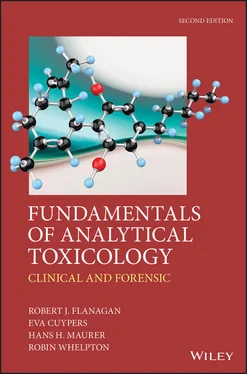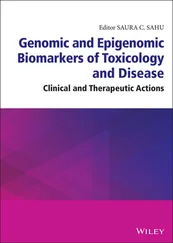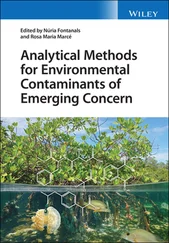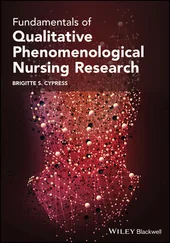In assessing the evidence of the analytical toxicologist, courts of law are concerned especially with the experience of the analyst, the origin and condition of the samples, and the analytical methods used. The ability to prove continuous and proper custody of the specimen is important. It used to be argued that evidence from a minimum of two unrelated analytical methods should be employed before a tentative identification is accepted, but with the advent of GC-MS and LC-MS methods this is often no longer the case, the MS data being regarded as orthogonal to the chromatographic data. The results should be presented together with sufficient information to ensure accurate interpretation of the findings by a coroner, magistrate, judge, and/or jury. There is always the possibility of an independent examination by a further expert instructed by another party in the case.
1.4.3 Testing for substance misuse
The value of blood, breath, or urinary measurements in the diagnosis of ethanol misuse and in monitoring abstinence is clear. Screening for substance misuse in urine is also valuable in monitoring illicit drug taking in dependent patients and guards against prescribing controlled drugs for patients who are not themselves drug dependent. Some substances disappear from biological samples very rapidly and, depending on the time between administration and sample collection, the parent compound may not be detectable. Sometimes, however, metabolite identification can be used to demonstrate systemic exposure to a particular drug. 2-Ethylidene-1,5-dimethyl-3,3-diphenylpyrrolidine (EDDP) is monitored to demonstrate systemic exposure to methadone, for example. Other samples, such as oral fluid, exhaled air, sweat, and meconium can also provide useful samples for specific purposes (Pleil, 2016; Chapter 18).
Analysis of hair, long advocated as a way to assess exposure to toxic metals, can also provide a history of exposure to illicit drugs and other organic poisons, but care is needed in the interpretation of results. Analytes including metabolites can arise in or on hair in many ways, and indeed attempts to remove external contamination may move analytes from the hair surface into the medulla, giving the impression that the analyte was present in the body when the hair was formed in the hair follicle (Cuypers & Flanagan, 2018).
Testing for substance misuse may also be valuable in the psychiatric assessment of patients presenting with no overt history of drug misuse. In addition, the diagnosis of maternal drug use, either during pregnancy or post-partum, can be important in the management of the neonate. The need for substance misuse screening of personnel in sensitive positions (armed forces, security services, pilots, drivers) or those applying for such positions (‘employment’ and ‘pre-employment’ screening, respectively), has become accepted in recent years. The detection of illicit or performance-enhancing drug use in sport has also assumed importance. In animal sports the definition of an illicit compound is much easier than in man and can include any substance not normally derived from feedstuffs.
The illicit drugs encountered most commonly in the UK are opioids, mainly heroin ( Box 1.1), cocaine, amfetamines including amfetamine, metamfetamine and methylenedioxymetamfetamine (MDMA, ‘ecstasy’), and cannabis. In the US, misuse of cocaine either as the hydrochloride, or as the free base (‘crack’) is relatively common, and a range of additional compounds may also be encountered, including dextropropoxyphene (propoxyphene), fentanyl and its analogues, and phencyclidine (PCP, ‘angel dust’).
Worldwide, whilst traditional drugs such as alcohol, cocaine, heroin, and metamfetamine, continue to dominate, the last few years have seen the emergence of so-called ‘legal highs’ (new or novel pharmaceutical substances, NPS), which can be divided broadly into novel stimulants, synthetic cannabinoids, and analogues of fentanyl and other synthetic opioids such as carfentanil. Increasingly these compounds are mentioned on death certificates in England and Wales. The synthetic opioids and cannabinoids are particularly potent and thus dangerous (Handley et al ., 2018).
The purity of ‘street’ drugs varies widely – heroin may be between 2 and 95 % pure, for example. Overdosage, either with excessively pure ‘street’ drug, or with drug ‘cut’ with a particularly toxic compound such as strychnine, is a further cause of acute poisoning ‘epidemics’. Compounds such as atropine, barbiturates, chloroquine, ephedrine, levamisole, lidocaine, methaqualone, phenacetin, phentermine, quinine, and strychnine may be used to ‘cut’ street drugs. Serious acute poisoning may occur if tolerance to heroin or methadone has been reduced through abstinence. Methadone is widely used in the management opioid addiction, although buprenorphine is also employed in this role. Misuse of other opioids such as codeine, dihydrocodeine, oxycodone, and pethidine (meperidine) may also be encountered.
The availability of a variety of immunoassay kits has proved invaluable, especially in employment and pre-employment screening when large numbers of negative results are to be expected and high sensitivity is required. However, confirmation of positive results with MS linked either to capillary GC or LC is essential. In clinical samples TLC can be used to resolve drugs such as morphine from compounds such as codeine and pholcodine that are available in over-the-counter preparations. TLC requires a minimum of apparatus and is generally cost effective. It is also amenable to batch sample processing, but is labour intensive, analyte capacity is low, and interpretation of results can be anything but straightforward. Capillary GC, GC-MS, or LC-MS is used to detect and identify amfetamines, and increasingly to confirm immunoassay results.
Ingestion of diuretics and/or laxatives either to produce weight loss, or to provoke covert alterations in body biochemistry (Munchausen syndrome, factitious illness) is uncommon and can be difficult to diagnose. Collection of serial urine samples over several days is advisable (Section 22.4.12). Detection of the misuse of osmotic laxatives such as lactulose and bulk-formers such as bran is not possible analytically. The covert ingestion or administration of anticoagulants and antidiabetic drugs is also well documented, but can be difficult to diagnose.
1.4.4 Therapeutic drug monitoring
The measurement of plasma concentrations of drugs given in therapy is useful in assessing adherence and for compounds for which pharmacological effects cannot be assessed easily and for which the margin between adequate dosage and overdosage is small, as discussed in Chapter 20. The availability of a variety of immunoassay and other kits means that many TDM assays can be performed more conveniently by such means than by chromatographic methods. However, chromatographic assays are still important in the case of antiepileptic, antimicrobial, antipsychotic, and immunosuppressant drugs, for amiodarone, where it has proved impossible to produce an antibody that does not cross-react significantly with thyroxine and tri-iodothyronine, and in general where active metabolites need to be measured as well as the parent compound. Examples include carbamazepine/carbamazepine-10,11-epoxide, clozapine/norclozapine, procainamide/ N -acetylprocainamide, and amitriptyline/nortriptyline.
1.4.5 Occupational and environmental toxicology
The monitoring of occupational or environmental exposure to toxic substances is an important area. Metal ions such as lead and also some organochlorine pesticides such as chlordane and dieldrin have long half-lives in the body and thus accumulation can occur with prolonged exposure to relatively low concentrations. The manufacture of drugs can also present a hazard to those involved via either dermal, or inhalational absorption. The misuse of alcohol and of controlled drugs is of concern in occupational medicine, especially as regards screening for substance misuse amongst potential employees and amongst, for example, operators of heavy machinery and pilots, as discussed above.
Читать дальше












